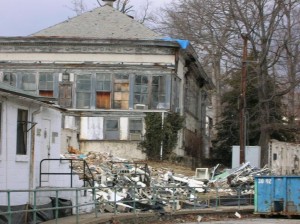Guest Post by Lisa Mroszczyk
Think of all the energy it has taken over generations to build the County’s existing building stock. This expenditure is embodied energy—the energy already invested to process materials, transport them, and finally construct a building. Demolition wastes embodied energy. When that waste is factored in with the energy needed to transport demolished building materials to a landfill and the energy needed to construct a new building on the site, any net energy savings typically doesn’t kick in for three or four decades.

Reusing existing buildings conserves energy and reduces construction and demolition debris in landfills. During National Preservation Month, we are reminded of historic preservation’s role in sustainability.
- The Brookings Institution predicts that by 2030 we will demolish 82 billion square feet or 1/3 of the existing commercial space. This is enough construction debris to fill 2,500 football stadiums.
- According to information compiled by the National Trust for Historic Preservation, building a new 2,000 square foot house generates 4 pounds of trash per square foot, of which only 20-30% is recycled, and
- Construction of a new 50,000 square foot commercial building requires as much energy as it would take to drive a car 20,000 miles per year, for 730 years.